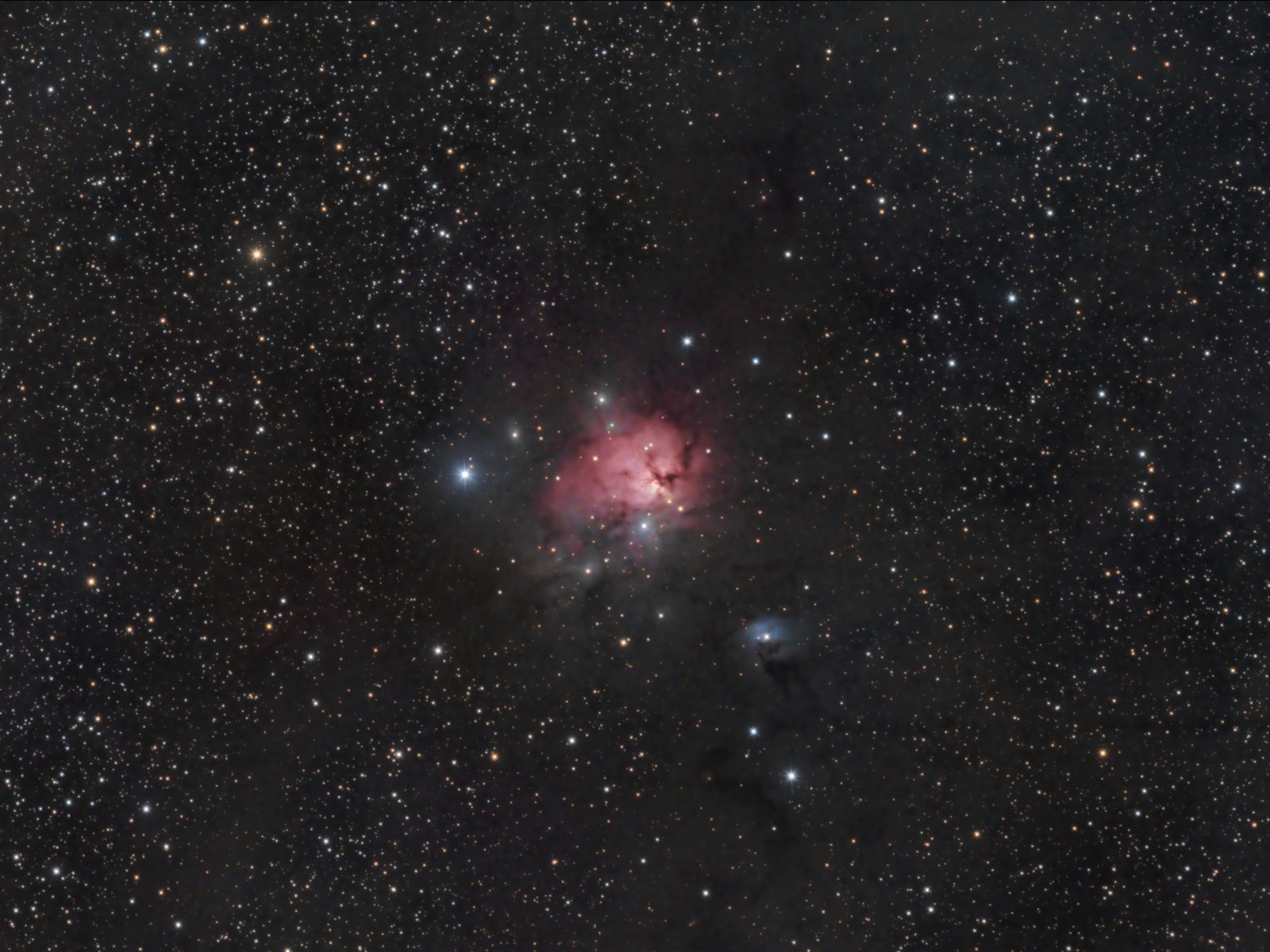NGC 1579, The Northern Trifid Nebula
Click image for full size version
February 13, 2022
NGC 1579 is known as the Northern Trifid Nebula. It is smaller and further away than its namesake, lying 2,100 light years away in the constellation Perseus. It is about 3 light years across and contains both reddish and blue components. The blue is reflection nebula, where dust behind the stars reflects starlight. The red in this case is not from the usual emission of hydrogen. According to NASA’s APOD write-up, it is the light of a massive young star that emits strongly in hydrogen alpha, and whose light is being dimmed and reddened by dust within the core of the nebula. Additional dust and soot is evident above and below the nebula in large areas that contain few stars.
Tekkies:
Acquisition, focusing, guiding, and control of Paramount MX mount with N.I.N.A, TheSkyX and PHD2. Focus with Optec DirectSync motor and controller. Equipment control with PrimaLuce Labs Eagle 4 Pro computer. All pre-processing and processing in PixInsight. Acquired from my SkyShed in Guelph. Average or better transparency and seeing. Data acquired January 15-31, 2022.
Sky-Watcher Esprit 150 f/7 refractor and QHY16200M camera with Optolong 3nm H-alpha and LRGB filters
17x10m R = 2hr50m
16x10m G = 2hr40m
16x10m B = 2hr40m
38x10m L = 6hr20m
9x20m Ha = 2hr40m
Total 17hr10m
Data Reduction and Initial Processing
Preprocessing: The WeightedBatchPreProcessing script was used to create master frames An RGB image was made from the red, green and blue masters. The L, Ha and RGB masters were were cropped with DynamicCrop to remove edge artifacts and DBE was applied to each of the three masters using Subtraction. ColourCalibration was applied to the RGB Image.
Colour
Linear Noise Reduction: MultiscaleLinearTransform was used to reduce noise in the background areas. Layer settings for threshold and strength: Layer 1: 3.0, 0.5 Layer 2: 2.0, 0.35 Layer 3: 1.0, 0.2 Layer 4: 0.5, 0.1
Stretching: GeneralizedHyperbolicStretch was applied to make a pleasing yet bright image. TGVDenoise was applied and the image was re-stretched to reset the black point.
Luminance
Deconvolution: A star mask was made from the Luminance master to use as a Local Deringing Support Image. A stretched clone of the H-alpha image was used to make a mask selecting bright regions of the nebula for deconvolution. Deconvolution was applied (30 iterations, regularized Richardson-Lucy, ParametricPSF mode with default settings; Global dark deringing = 0.02; Global bright deringing 0.007).
Linear Noise Reduction: MultiscaleLinearTransform was used to reduce noise in the background areas. Layer settings for threshold and strength: Layer 1: 3.0, 0.5 Layer 2: 2.0, 0.35 Layer 3: 1.0, 0.2 Layer 4: 0.5, 0.1
Stretching: GeneralizedHyperbolicStretch was applied to make a pleasing yet bright image. TGVDenoise was applied and the image was re-stretched to reset the black point.
H-alpha
Linear Noise Reduction: MultiscaleLinearTransform was used to reduce noise in the background areas, using an internal mask to protect bright stars. Layer settings for threshold and strength: Layer 1: 5.0 0.75, 1 iteration; Layer 2: 4.0, 0.6, 1 iteration, Layer 3: 3.3 0.5, 1 iteration; Layer 4: 1.0, 0.25, 1 iteration.
Stretching: GeneralizedHyperbolicStretch was applied to make a pleasing yet bright image. TGVDenoise was applied and the image was re-stretched to reset the black point.
Combining Luminance, H-alpha and Colour Images
Luminance addition: LRGBCombination was applied to replace the lightness of the RGB image with the Luminance master.
H-alpha Blending: PixelMath was used to add H-alpha to the LRGB image (the target image, $T), using the following expressions for the R, G and B channels:
R: max($T[0], 1.2*Ha)
G: $T[1]
B: iif($T[0]<Ha, $T[2] + 0.06*Ha, $T[2])
Additional Processing
Star Removal: StarNet v2 was used to remove stars.
Nonlinear Noise Reduction: TGVDenoise was used in L*a*b* mode to reduce noise with a mask used to target the background areas and protect nebula (max. 1,000 iterations and convergence selected for both lightness and chrominance).
Contrast Enhancement: LocalHistogramEqualization was applied using an inverted lightness mask to protect the background and select the nebula. Three passes were applied (scale 20, max contrast 1.5, strength 0.25, 1 iteration, scale 50, max contrast 1.5, strength 0.3, 1 iteration, and scale 150, max contrast 1.5, strength 0.22).
Sharpening: MultiscaleMedianTransform was used to sharpen Layers 2 – 4 with strengths of 0.1, 0.07 and0.05, respectively.
Star Restoration: Stars removed using StarNet2 above were added back into the image using straight addition.
Final Steps: The DarkStructureEnhance script was applied with a strength of 0.25. Background, nebula and star brightness, contrast and saturation were adjusted in several iterations using CurvesTransformation with masks as required. ICCProfileTransformation (sRGB IEC61966-2.1; Relative Colorimetric with black point compensation) was applied prior to saving as a jpg.







Very beautiful the stars and the detail of the nebula. Congratulations Ron a nice job. Even the sky background is well calibrated.
Nice image, Ron.
It’s uncanny how like ‘our’ Trifid it is – except of course for the beautiful blue! I suppose knocking down the wall of your observatory to get at it would be a bit extreme!!!
As always, your processing notes are are great – each one a lesson in Pixinsight.
Mark
Awesome 😎!